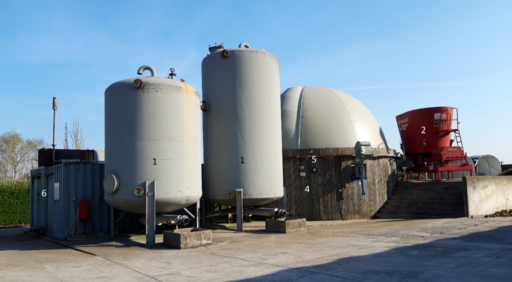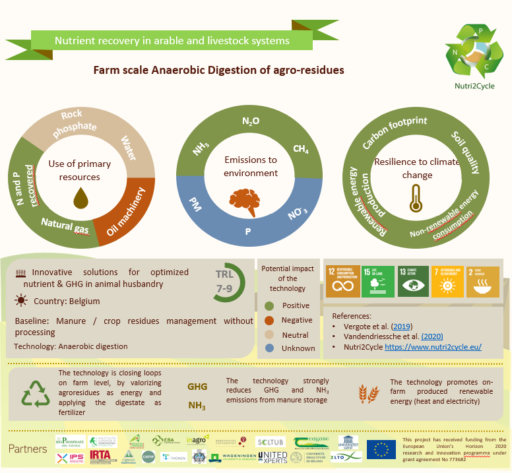1. Farm-scale anaerobic digestion of agro-residues/pig manure to increase local nutrient cycling & improve nutrient use efficiency
RL1: Innovative solutions for optimized nutrient & GHG in animal husbandry
Responsible partners: Inagro & Ghent University
Country: Ghent, Rumbeke-Beitem, BELGIUM

TRL and scale of set up:
This demo is considered to be at operational TRL 9 and has been set up through biogas installation at Inagro with a 31 kW pocket (farm-scale) digester, making it directly comparable to other pocket digesters and thus very relevant for farmers. The pocket digester (mesophilic temperature range) can be fed with different input streams to assess co-digestion conditions for small scale anaerobic digestion.
Research line and priority:
This demo solution is linked to Nutri2Cycle research line 1 (RL-1: Innovative solutions for optimized nutrient & GHG in animal husbandry) and is one of the shortlist priority solutions i.e. sub-research line 13 (Anaerobic digestion strategies for optimized nutrient and energy recovery from animal manure).
Description of the demo:
Farm-scale anaerobic digestion is a technique by which farmers can create their own energy by valorising agro-residues (e.g. manure and/or crop residues). The technique has been increasing over the last decade. To date, this technology occurs almost exclusively on dairy farms. The demo is conducted in the small scale anaerobic digester of Inagro, operational since 2007. In Flanders, there are about 60 farm scale anaerobic digesters, of which only 2 operating on pig manure: the pig farm Akivar and research institute Inagro vzw.. This small-scale AD plant is a classical CSTR reactor with a total volume of 200 m³ and a nominal volume of 150 m³. The installation has an electrical power of 31 kW and is operated at mesophilic temperatures (± 38 °C). The biomass is being mixed by a Peters Fermento Mixer (11 kW), adjustable in height and width. Prior to burning the biogas in a CHP unit, water vapour and sulphur are removed from the biogas by a condensation step and biological desulphurization, respectively.
How it addresses the Nutri2Cycle goals:
This solution is a great example of closing CNP loops, since in the first place there is energy recovery from manure. In the second place, nutrients (N, P) are being recovered in digestate as a fertilizer. During the process, C is transferred into methane (CH4) and carbon dioxide (CO2). However, part of the non-easily degradable C remains available for the soil microorganisms. Hence, it also contributes to soil health.
Infographic



 This project has received funding from the European Union’s Horizon 2020
This project has received funding from the European Union’s Horizon 2020